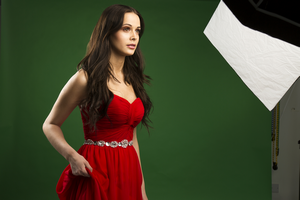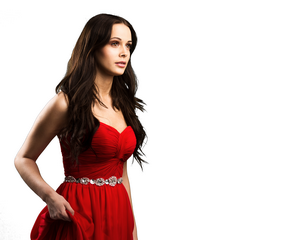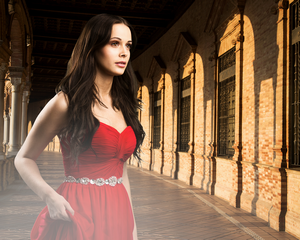Green screens and blue screens have been used for decades for filmmaking and photography and have become an invaluable part of a photographer's toolkit. By photographing subjects against a green screen or a blue screen, they can be easily isolated and placed onto a new background.
Here is an example of a model photographed against a green screen:

PhotoKey instantly removes the green screen background from the photo, leaving a cleanly isolated version of the woman:

PhotoKey can then be used to add in a new background and make other adjustments to positioning and appearance:

Automatically removing the green screen or blue screen from the original image is known as 'keying', a process designed to eliminate or reduce the amount of manual work required. PhotoKey 8 Pro is the fastest and easiest green screen photographic software and is designed for both individual portrait work and mass processing at major live events.
Green screen or blue screen?
The most important aspect of keying is to ensure that the background screen can be easily separated from the foreground subject. You want your screen to be as different to your subject in color as possible.
This is why red screens are not commonly used - due to the amount of red in human skin, it's impossible to get good results with a red screen. Green and blue are both far less prominent in skin tones and therefore work as successful keying colors. Take careful note of clothing, hair and other objects in the shot and make sure that you choose an appropriate backdrop.
If you absolutely can't avoid some color clashes, take a look at the Masks chapter.
Some digital cameras also have a tendency to retain more green data than blue, so if you are in a position to freely use either green or blue it is generally advisable to choose green.
Blue screens and green screens can be purchased or rented, or you can build your own using appropriate materials. For portability a fabric screen works well, as do pop-up screens (similar to pop-up reflectors). A pull-down paper screen which can be rolled up when not in use is ideal for a studio. If you have a permanent studio space for green screen work you can also consider chroma green paint.
Setting up your green screen
Greenscreen and bluescreen photography has a few unique factors to bear in mind.
Taking a little more time during setup can save you a huge amount of time when you get on the computer.
| • | Make sure your material is matte, not shiny. Shiny backgrounds will reflect too much light and have bright 'hotspots'. |
| • | Avoid textured materials - go for smooth materials that won't cast any shadows. Textures can make it difficult to separate the subject from the background. |
| • | Clear separation between screen and subject is the key to high quality results. |
| • | Avoid creases and wrinkles in the backdrop. These can cast shadows and cause imperfections in the composite. |
| • | Always try to position your subject as far away from the backdrop as possible. This will reduce the amount of green or blue that is reflected onto them and avoid casting shadows onto the screen. Aim for a minimum of 6 feet when possible, although PhotoKey will still work in tighter setups. |
| • | Make sure your subject is not casting any unwanted shadows on the backdrop. Shadows will make compositing much more difficult. |
| • | Light your backdrop independently from your subject. This enables you to light your background smoothly while retaining a more dramatic setup for your subject. |
| • | If you are getting a lot of bounced green spill light on your subject try adding a very subtle magenta light behind your subject. This can help to counter green spill light from the greenscreen and increase separation. |